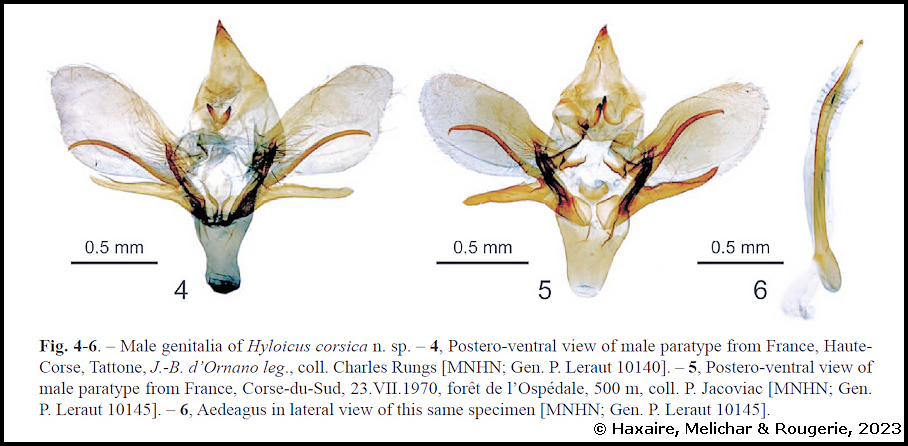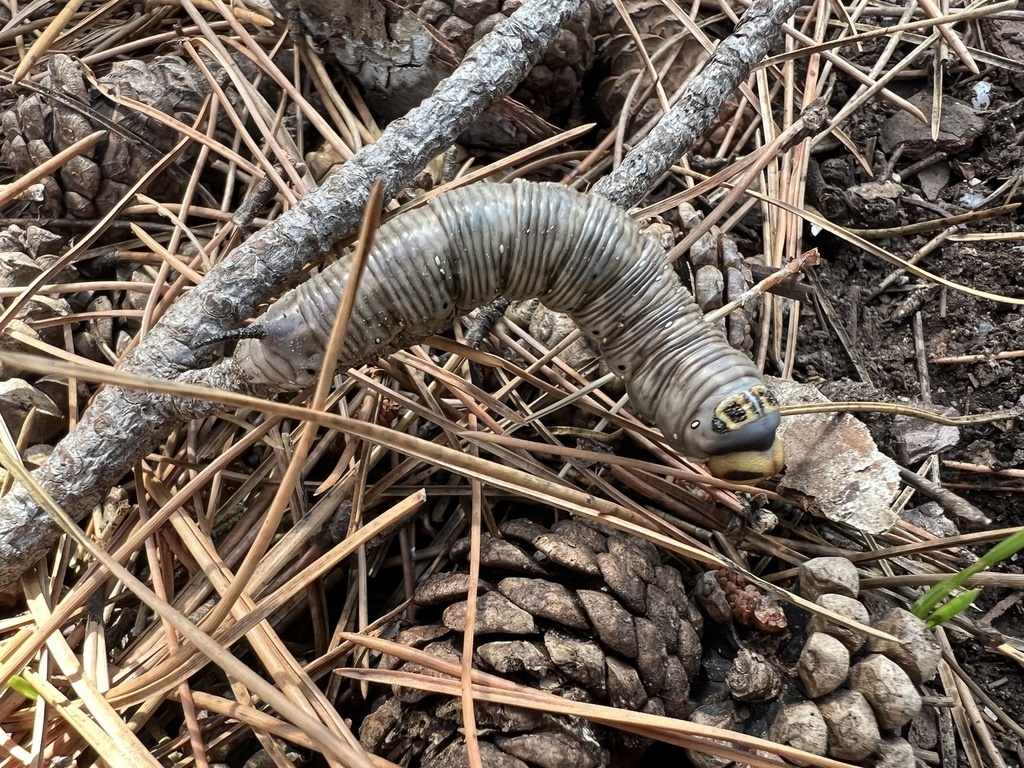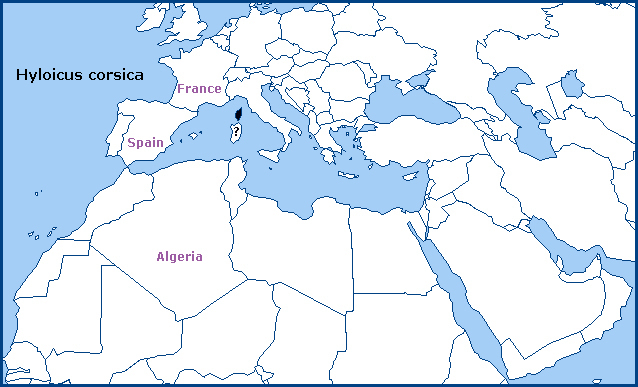UK: Corsican Pine Hawkmoth
Hyloicus corsica Haxaire, Melichar & Rougerie, 2023, Bulletin de la Société entomologique de France 128(4): 626.Type locality: Mausoleo, Tartagine, Haute-Corse [, Corsica], 1200 m.
(Taxonomic notes. Distinguished from Hyloicus pinastri (Linnaeus, 1758) and Hyloicus maurorum Jordan, 1931, by its slightly larger overall size and a small but consistent genetic divergence in the standard DNA barcode marker (a fragment of the COI gene). However, although the male genitalia differ only slightly from those of Hyloicus pinastri, they differ significantly from those of Hyloicus maurorum (Haxaire, Melichar & Rougerie, 2023).)
[Further details on this species, as well as photos of all stages, can be found on Lepiforum.]
Holarctic; western Palaearctic region. Pleistocene refuge: Monocentric -- The island of Corsica, Mediterranean refuge.
![Upperside of male Hyloicus corsica, Mausoleo, Tartagine, Haute-Corse [Corsica], 1200m, 42°49040'N 8°97745'E, leg. J. Barbut & R. Rougerie [HOLOTYPE]. Photo: © Haxaire, Melichar & Rougerie, 2023. Upperside of male Hyloicus corsica, Mausoleo, Tartagine, Haute-Corse [Corsica], 1200m, 42°49040'N 8°97745'E, leg. J. Barbut & R. Rougerie [HOLOTYPE]. Photo: © Haxaire, Melichar & Rougerie, 2023.](s_cor_a1.jpg)
![Underside of male Hyloicus corsica, Mausoleo, Tartagine, Haute-Corse [Corsica], 1200m, 42°49040'N 8°97745'E, leg. J. Barbut & R. Rougerie [HOLOTYPE]. Photo: © Haxaire, Melichar & Rougerie, 2023. Underside of male Hyloicus corsica, Mausoleo, Tartagine, Haute-Corse [Corsica], 1200m, 42°49040'N 8°97745'E, leg. J. Barbut & R. Rougerie [HOLOTYPE]. Photo: © Haxaire, Melichar & Rougerie, 2023.](s_cor_a2.jpg)
Wingspan: 78--88mm. Superficially indistinguishable from French examples of Hyloicus pinastri and Hyloicus maurorum (Haxaire, Melichar & Rougerie, 2023). [For a typical live adult see Christoph Moning, iNaturalist 2022].
In the male genitalia, the valves are large and elongated, distally rounded, with a very distinctive, large and sclerotized sacculus arising from their ventral margin at the base of the valve where they join the vinculum. The harpe is formed of two long and tapered processes. The upper branch is much longer than the lower, more or less heavily curved, almost always cylindrical in its apical half and with only rudimentary prongs (see below). The ventral process of the harpe is shorter, half as long as the valve, and stronger though less sclerotized than the dorsal process; it is conical in its proximal part, flattening and tapering toward its tip (Haxaire, Melichar & Rougerie, 2023). The genitalia are thus very similar to those of Hyloicus pinastri. This is markedly different from that of Hyloicus maurorum, where both branches of the harpe are short, the upper one flat, pronged, triangularly elongated and pointed.
DNA barcodes obtained from nine specimens of Hyloicus corsica from four separate sites in northern, central and southern Corsica form a distinct BIN (Barcode Index Number; Ratnasingham & Hebert, 2013): BOLD:ADW0182 with average and maximum intraspecific genetic distances (uncorrected p-distance) of 0.04% and 0.15%, respectively (Haxaire, Melichar & Rougerie, 2023).

Dry forests of Corsican Pine (Pinus nigra subsp. laricio (Poir.) Maire, 1928) at 600 to 1300m altitude (Haxaire, Melichar & Rougerie, 2023).
Mainly June and July; however, individuals have been captured in early May and early August (Haxaire, Melichar & Rougerie, 2023).
OVUM: Unknown.
LARVA: Full-fed 75--80mm.

Only known from a single photo of a pre-pupation larva from the ForÍt Communale de Zonza, Corsica, and posted on [iNaturalist 2022] as Hyloicus maurorum by tobiwankenObi. The basic body colour is medium grey. The body segments are distinctly separated one from another, and each segment in turn is subdivided by sunken, dark, transverse lines so that the entire body appears to consist of numerous narrow rings joined together. It is thus similar to that of Hyloicus maurorum. Horn black, thin, gently curved, and distinctly granulose. The body is smooth, but not glossy, unlike the head and shield.
Hostplants. Almost certainly Corsican Pine (Pinus nigra subsp. laricio).
PUPA: Unknown.
Unknown.
So far, only known from Corsica.
It has been collected from sites in southern, central (Julien Bottinelli, iNaturalist 2024) and northern Corsica and it is therefore likely to be distributed throughout the island at elevations between 600 and 1300m, wherever Corsican Pine forests are found. Interestingly, there is an iNaturalist observation of 'Sphinx pinastri' from northern Sardinia [see Andrea Stangoni, iNaturalist 2021]. The image is of a very worn adult, which precludes any form of identification: it may or may not be Hyloicus corsica (Haxaire, Melichar & Rougerie, 2023).
The population on Corsica (Bretherton & de Worms, 1963) has been classified at various times as Hyloicus pinastri or Hyloicus maurorum (Haxaire, 2009; Haxaire, pers. comm 2018; Haxaire, 2019).
Extra-limital range. None.

None.
 Return to species list
Return to species list